The History of Chickens
Posted on: July 18th 2022

We call the doctor’s handwriting chicken scratch, refer to a hierarchy as a pecking order, warn people not to count their chickens before they hatch, tell cock-and-bull stories, joke about the chicken crossing the road and occasionally decide to take someone under our wing. Chickens seemingly show up everywhere in our everyday conversations. And they show up frequently on our tables, as well.
Americans love chicken, but have you ever considered the journey chickens took to get to the U.S. and to your dinner plate? This history starts millions of years ago with a humble jungle bird that likely had no idea it was destined for greatness.
Which Came First — the Chicken or the Egg?
This question was first posed, at least in writing, by Plutarch in the first century A.D. More precisely, the famous Greek philosopher wrote, “Who was born first, the egg or the hen?” The chicken or egg dilemma is often referenced whenever there is a question about cause and effect since you need a chicken to lay an egg, and you need an egg to hatch a chicken. So it seems impossible to have one exist without the other.
Today, the question is meant to be symbolic and rhetorical, so you aren’t likely to hear anyone answer back with their theory of chickens and eggs. But scientists today do have an answer to Plutarch’s puzzling question. And that answer reveals a lot about the history of chicken eggs and chickens. According to a molecular paleobiologist at Yale University, the egg came long before the chicken. We don’t know exactly when and where eggs originated, but scientists estimate it was hundreds of millions of years ago.

Reptiles and, later, birds have always laid eggs to reproduce. The earliest eggs were likely soft, similar to turtle eggs today, and later evolved to develop a harder shell. Among the many species that laid eggs, some were the progenitors of chickens. These wild fowl didn’t arrive on the scene until about 21 million years ago. We’ll learn more about that species in the next section.
When it comes to evolution, it can be difficult to pinpoint an exact moment when a distinct species emerged. But at some point in history, the chicken’s ancestors laid eggs, and out popped a chick that would grow up to be a bit different than its parents. It would grow up to be a chicken. Mystery solved — The egg came first. That said, those first chickens likely looked different to chickens today since they continued to evolve.
Where Did the First Chicken Come From?
The modern domesticated chicken’s most direct ancestor is the red jungle fowl, also known by its scientific name, Gallus gallus (G. gallus). Charles Darwin first posed this theory, and it has now been confirmed by DNA research. The chicken is so closely related to the red jungle fowl that it shares the same classification of G. gallus, though some distinguish domesticated chickens by using the label G. gallus domesticus or simply G. domesticus.
These birds share many similarities, so it’s easy to see the connection, even without the DNA evidence to back it up. A male red jungle fowl looks remarkably like some modern breeds of domesticated roosters, such as the Welsummer and Derbyshire Redcap, for example. It has fleshy red wattles and a red comb on its head. Its plumage is shiny and red-orange on the head and back and blackish-green on other parts of the body. These males also have spurs on their legs and crow just like a domesticated rooster.
Female G. gallus also resemble domesticated hens and behave similarly, making clucking noises and brooding eggs. Both sexes of G. gallus can be found in forests across northeastern India to the Philippines, where they peck the ground for food like insects and seeds. They cannot fly far, but they do fly up into the trees to roost at night.
Scientists believe that G. gallus bred with at least one other species, and possibly more, to create chickens as we know them today. The gray jungle fowl (G. sonneratii) of southern India was one of those contributing species and is likely where many chickens got their yellow skin.
As you can see from this genealogy, chickens come from Asia. As popular as they are in the U.S. today, many people might wonder whether chickens are native to America. Chickens have been in America for hundreds of years, but they are not native to the continent or even to the western hemisphere. Chickens spread to many parts of the world once they were domesticated and not before since they are not naturally migratory.
The domestication of chickens is also what helped along their evolutionary process to make them a bit less like their wild fowl ancestors and more like modern barnyard chickens. Over the years, people bred chickens to promote certain desirable traits, like plumpness and efficient egg-laying.
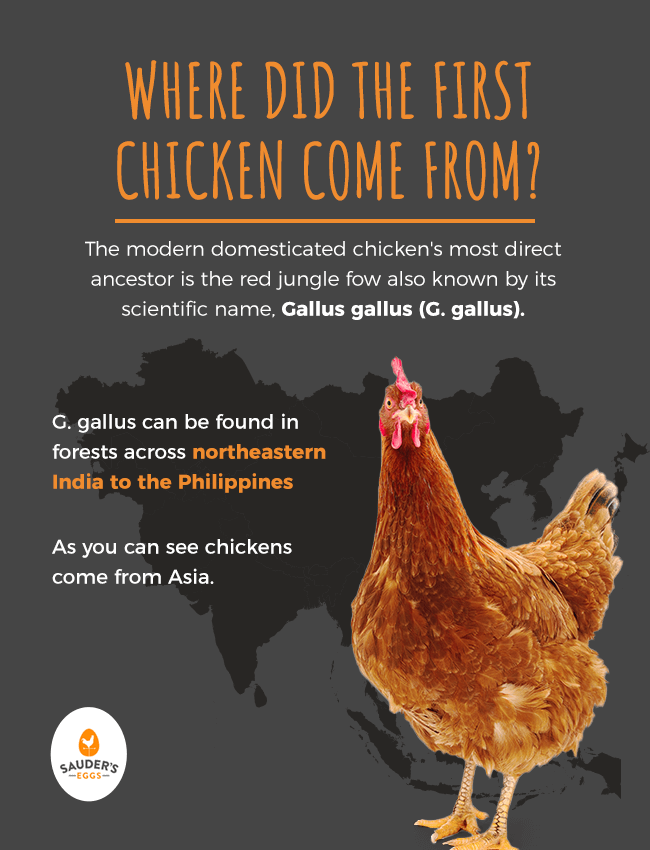
The Domestication of Chickens in the Ancient World
It’s difficult to pinpoint exactly when people began domesticating jungle fowl and their descendants. This domestication likely started over 7,000 years ago in the red jungle fowl’s native home of southeast Asia and possibly India, as well. Interestingly, though, many archeologists and historians believe chickens weren’t originally domesticated for food.
Instead, it was likely the entertainment of cockfighting that motivated humans to keep chickens. Roosters have natural fighting instincts and leg spurs for weapons. The sport first became popular in ancient Eastern societies. In the sixth and fifth centuries B.C., cockfighting took off in the cultural center of Greece. Then, it spread to Rome and throughout many parts of Europe. Eventually, it made its way into many other parts of the world, as well.
Spectators would gather around the pit and place bets on which gamecock would emerge the victor. Often, this was determined by which one survived the brutal fight. The roosters’ spurs were made more deadly by the addition of sharper materials like metal objects. Today, many consider cockfighting inhumane, and the sport is illegal in all 50 states in the U.S.
Ancients weren’t just using chickens for cockfighting. Chickens also seemed to hold some ritualistic and religious significance since archeologists have uncovered figurines and artwork depicting chickens, and they were sometimes included in burials or used in religious sacrifices. Egyptians hung eggs in their temples to promote an abundant river flood. In Zoroastrianism, an ancient Persian religion, roosters’ crows were considered a divine signal that the evil of night had been overcome by the light.
Roman armies believed that a chicken’s appetite could help them foretell the results of a battle. 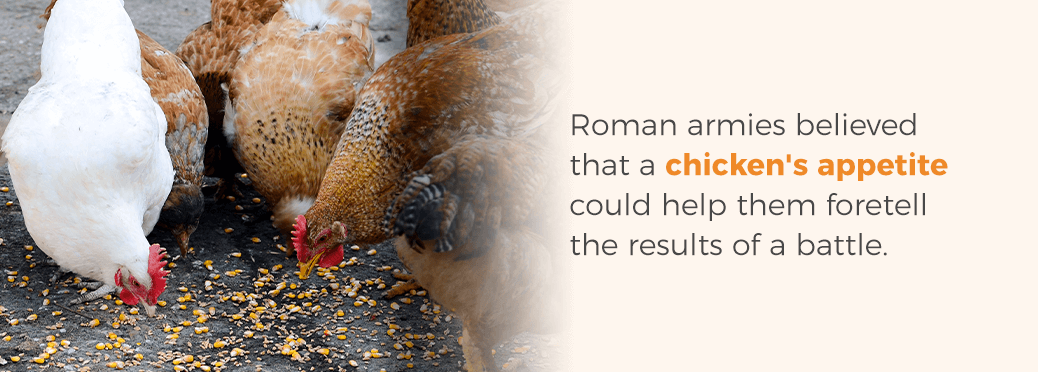
A hungry chicken eager to eat meant victory was likely, but chickens who were indifferent toward food signified a likely defeat.
Clearly, domesticated chickens served many roles, but it took a while before they were raised primarily as a food source. Researchers have found that the earliest known site in the ancient world where chickens were widely raised for economic reasons was in Maresha, Israel, during the Hellenistic period — the fourth through second centuries B.C. A large quantity of chicken bones, with most belonging to female chickens, lends support to this theory. In Europe, the available evidence suggests people began using chickens economically in about the first century B.C.
By historical accounts, chicken seemed to be a popular dish in Rome and Greece for a time. The Romans are even credited with inventing the forerunner to the omelet — a mixture of egg sweetened with honey. But after this initial trend, chickens fell out of popularity as a food source for centuries.
The Domestication of Chickens in the Middle Ages
Domesticating chickens as a food source picked up between the ninth and 12th centuries A.D. in Europe, as evidenced by a spike in the number of chicken bones uncovered dating back to this time. One possible reason for the rise in chickens’ popularity during this era had to do with Christian rules on fasting.
In particular, fasting practices that originated with the Benedictine Monastic Order dictated that meat from four-legged animals was off-limits during fasting periods but poultry and eggs weren’t prohibited. It’s easy to see, then, why a person observing these religious edicts may want to have access to chickens and eggs to satisfy their hunger while still following the rules.
As chickens began being raised more for their meat and eggs, a genetic mutation resulted from selective breeding.
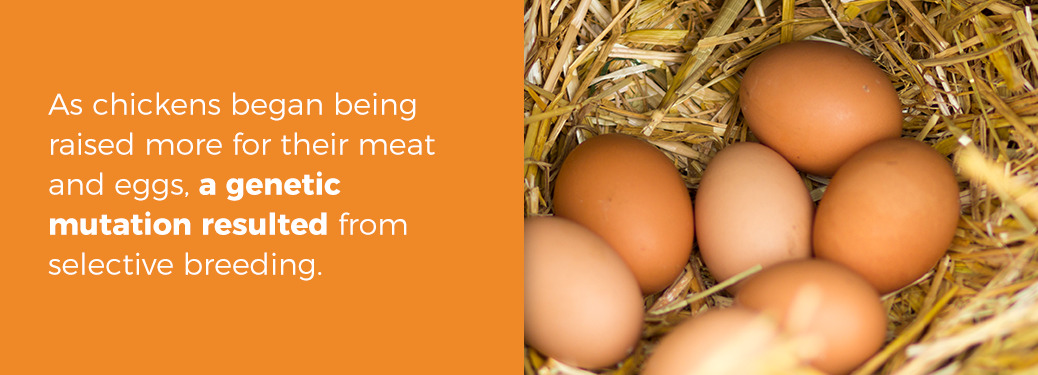
A study of chicken DNA concluded that around the year 920 A.D., the selection of a thyroid-stimulating hormone receptor (TSHR) gene variant began. Essentially, this variant allowed chickens to breed and lay eggs year-round rather than only during specific seasons. Of course, this was a convenient change for people who still today enjoy access to fresh eggs all year long.
Over time, another important mutation occurred that promoted weight gain in chickens, which of course, was good news for humans raising chickens to one day end up on their dinner plate. Chickens today continue to lay eggs year-round and offer a surprising amount of meat for their size, all thanks to early chicken farmers and selective breeding over time.
How Chickens Came to America
The question of how chickens got to the Americas has been hotly debated within the scientific community over the past 15 years or so. Some DNA research has suggested that chickens got to the Americas from Polynesians who visited South America long before Columbus made contact. That theory was based on an analysis of chicken bones found in South America that were thought to share unique similarities with bones from the Pacific.
However, other researchers have refuted the theory, claiming these similarities are not proof that South American chickens came from Polynesia since these same genetic similarities are found in all ancient chicken samples. These dissenting researchers point out that no South American chicken samples studied have contained genetic markers that are distinctly Polynesian.
So, how did the first chickens get to the Americas? This question remains a mystery so far, and it will likely continue to be debated and investigated by curious researchers. We do know how some chickens arrived during the colonization of the New World. During the 16th century, chickens were brought over from Europe, Asia, and Africa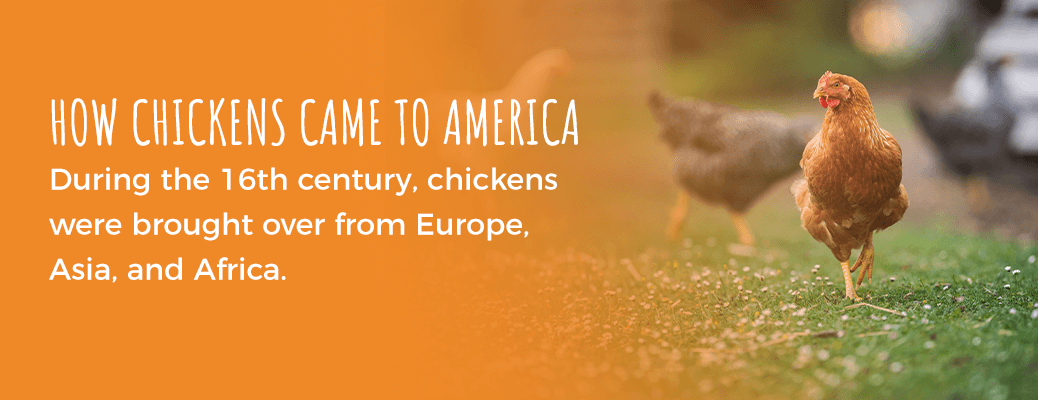
These African chickens were brought to the Americas as a result of the Dutch and Portuguese slave trade.
However chickens first got to America, they have long been a part of American farming and the American diet. According to the U.S. Department of Agriculture (USDA), most chickens raised for meat in the U.S. today come from the British Cornish breed and from the White Rock, which developed in New England. While chickens have long been a typical barnyard animal in America, it wasn’t until relatively recent history that chicken became the popular food we know today.
The Rise of the Modern American Chicken Industry
From fast food to fine dining, you can hardly visit a restaurant that doesn’t offer a variety of chicken dishes. So it may be surprising to know that chicken wasn’t always so popular in the U.S. The chicken industry’s history has humble beginnings. The 20th century is when chicken production began to boom, but the industry started out focused on egg production.
The Layer Industry
The story of the layer industry — that is, the part of the chicken industry focused on egg production — is a bit more straightforward than the broiler industry. Americans have long been convinced that eggs deserved a prominent spot on their breakfast tables and in a variety of dishes.
When more Americans lived rural lifestyles, it was common to have a few chickens in a backyard coop to produce enough eggs for the family. Extra eggs may have gone to a local farmer’s market for neighbors to buy. Closer to city centers, local farms supplied eggs to the townspeople. By the 1920s, in the U.S., eggs were quite a popular food, with people in Eastern cities eating about one egg per day.
As urban populations grew, eggs began being shipped, often from western states, via railcars to meet the demand. Farmers invented new ways to make the process more efficient and to improve the health and hygiene of chickens. By the early 1930s, farmers were using batteries for brooding and redesigning the way they housed hens.
By 1955, Americans’ per capita consumption of eggs was recorded at 369 — slightly more than one egg per day. That number decreased over the following decades of the 20th century as people questioned the nutritional value of eggs. However, dieticians today recognize that eggs have many health benefits for most people.
Eggs have risen again in popularity. In 2019, consumption of eggs was up to 293.6 eggs per capita in the U.S. The popularity of high-protein, low-carb diets has likely contributed to eggs’ renewed popularity.
For Americans looking for a healthy breakfast, for example, it’s hard to beat a delicious omelet or poached egg. Modern egg production has also made eggs an extremely affordable source of protein for Americans.
The Early Broiler Industry
As long as eggs were the focus of the modern chicken industry, most chickens sold at the market were young males, which were marketed as “spring chickens.” This is why older people may declare that they’re no longer a spring chicken. Chickens were sold whole and nicknamed “broilers.” These broilers were tender and a seasonal delicacy of sorts that could fetch a high price.
In fact, in 1928, the Republican Party used the phrase “a chicken for every pot” as a headline on an ad highlighting the prosperity and opportunity the party claimed to offer Americans.
Though chickens were largely a seasonal product, American cooks may have found the odd hen sold every now and then, though it would have been old and better slow-cooked in a stew since it was likely tough. Hens were only slaughtered and sold for meat once they could no longer produce eggs. The amount of available chicken meat per capita hovered around 10 pounds in the U.S. — about the same as fish and shellfish — until closer to the middle of the 20th century.
Large-scale poultry farms began to pop up throughout Great Britain two decades into the 20th century. In the U.S., it wasn’t until World War II that chicken farming took off on a more industrial scale.

The Modern Broiler Industry
As World War II raged, certain foods were rationed, including red meat. American wartime propaganda encouraged people at home to save certain foods for the soldiers and focus on other foods instead, including poultry. One poster from the U.S. Food Administration urged, “Eat more corn, oats and rye products — fish and poultry […] Eat less wheat, meat, sugar and fats to save for the army and our allies.”
During this time, American cooks became more familiar with preparing chicken and developed more of an appetite for poultry. Companies that produced livestock feed saw an opportunity at this time since chickens consume plenty of corn. If they could encourage more chicken production, they could also benefit from chicken farmers’ business.
Some farmers were interested in capitalizing on the rising demand for chickens, but many traditional banks would not approve loans for these ventures. So the feed companies stepped in, offering farmers the loans they needed to finance their new or expanded chicken farming operation. Their plan worked. Chicken farming expanded rapidly, and chicken steadily increased in popularity among Americans over the following decades all the way to today.
During the 1950s and ’60s, agricultural extensions published many recipes for cooking with chicken. This mild meat is so versatile that coming up with various ways to prepare it was easy. You could easily eat chicken for every meal of the week with hardly any resemblance between those meals.
This partnership between feed companies and chicken farmers also laid the groundwork for how many chicken farming operations work today. These partnerships have led to innovation in the farming of chickens. Over time, these integrated companies found ways to raise chickens that met both farmers’ and American consumers’ expectations of the perfect chicken. For example, this meant docile chickens with white feathers and generous proportions of breast meat.
According to the USDA, chicken surpassed pork in 1996 as the second most consumed meat after beef, and in 2010, it rose to the number one spot where it remains today. The amount of chicken available per capita in the U.S. today — 65.2 pounds — is double what it was in 1970.
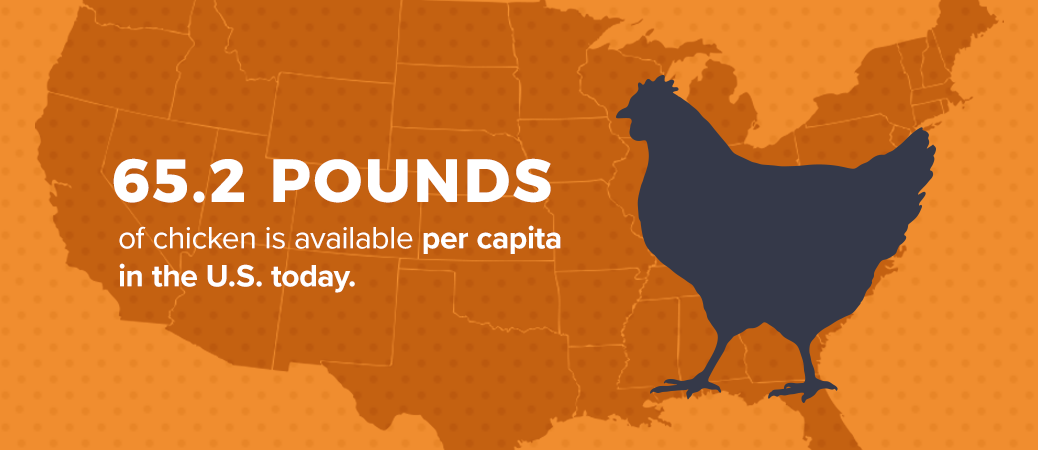
Younger generations may assume chicken was always the staple it is today, but their parents and grandparents know otherwise.
The History of Sauder’s Eggs
The history of chickens spans millennia and multiple continents across the world. Hopefully knowing a bit more about this history will make you appreciate that next fried egg or chicken dinner even more. At Sauder’s, we have a deep respect for the way our predecessors paved the way for modern farming practices.
Our company’s story began during the Great Depression when Frank Sauder, a farmer in Lancaster County, started selling eggs, fresh poultry, and other products from his farm to city folks in Philadelphia. Frank would go door to door, bringing the tastes and quality of the countryside to these happy consumers. Frank’s commitment to quality and fair prices earned him a positive reputation in the community, and his business grew.
Today, Sauder’s is still a family-owned and operated business, but we’ve grown to include hundreds of employees across multiple locations. Today, around 1.5 billion eggs are sold under the Sauder name annually. Look for Sauder eggs in your local grocery store.

